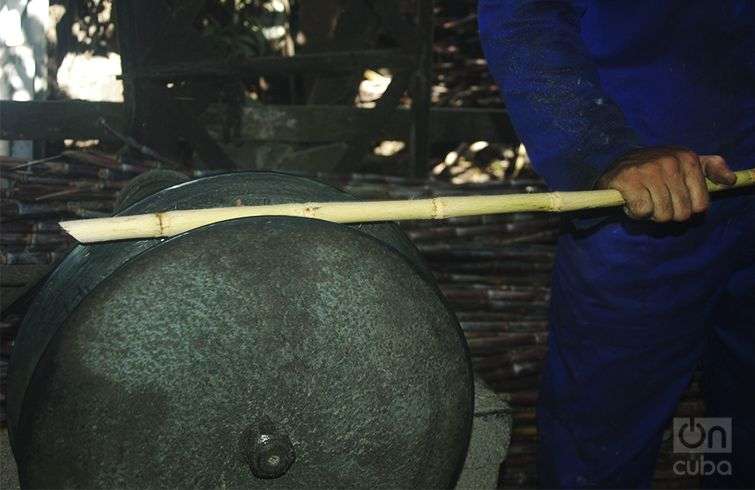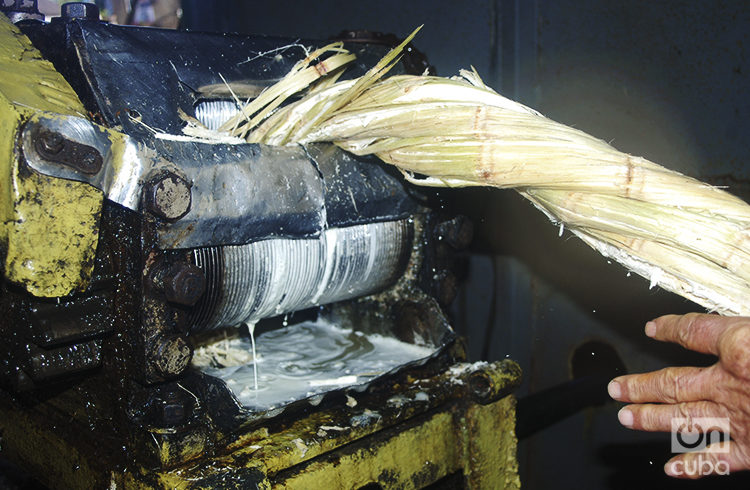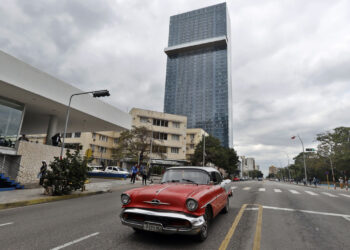Some historians say that sugar entered Cuba by Puerto Güincho, in Nuevitas, Camagüey, coming from the neighbor island Hispaniola. It came to stay, even in spite of ourselves.
In a month or a little more, the sugarcane harvest will start again in the country. The sugar industry (today still based on the production of sugar crystals and some syrup’s by-products) will have to become our “sugarcane industry” sometime, and eventually, we will be able to profit from all the potential of the grass.
Sugarcane—either starting from the plant or as a final destination—perhaps represents one of the biggest chances the archipelago has to boost a productive transformation process that may help us to live in a prosperous country. This achievement will depend on a lot of factors, but mainly on the change of many “settled mind-sets” used to their way of thinking and doing in the industry.
Cuba has a relation of love and hate, enthusiasm and frustration with sugar; this is no doubt an almost fetishist perception of the product. All our history, our culture, and a good deal of the Cuban imaginary have revolved around the cane juice, the sugarloaf, the syrup, the spirits, and, of course, the sugar.
Nowadays, with a little more than fifty working mills, the cane industry is still the best-distributed industrial system in the country. It has the most powerful renewable energy production network, thus generating a great deal of jobs in Cuba and supporting—directly or not—many Cuban families.
Some history

By the 19th century, sugar was one of the most important goods of the world production and exportation. By the mid-19th century, Cuba contributed almost 30 {bb302c39ef77509544c7d3ea992cb94710211e0fa5985a4a3940706d9b0380de} of the world output, and probably a higher percent of exports. In modern terms, we had a strategic positioning of undeniable advantage; still, our sugar production methods—far from allowing us to make good use of that advantage for further development—paved the way for the underdevelopment we suffer even today.
Some milestones of the sugar history of Cuba, mentioned by several Cuban academicians, are summarized in the following panorama. I only have to underline that sugar production is one of the key elements to understand our country’s relation with the United States, even before becoming a republic:
The first sugar mill of the Island was built in 1595 by Vicente Santa María, in the current province of Havana.
In 1740, the Royal Trade Company of Havana was created, taking over the monopoly of foreign trade and black-slave trade, and boosting sugar production.
Since the late 18th century, important technological breakthroughs were assimilated by the industry: the steam engine (1769), the sugar mill with horizontal iron crushers, the Rillieux’s evaporator, the vacuum pan, the centrifuge, and the railroad.
Around the mid-19th century, Cuba became the “sugar producer” of the world.
In 1892, production reached one million tons for the first time (1,006,538 t).
At the beginning of the century, the industry was reorganized by the hand of American capital, representing the 23.1 {bb302c39ef77509544c7d3ea992cb94710211e0fa5985a4a3940706d9b0380de} of investments.
In 1913, production reached two million tons for the first time.
In 1926, the first sugar refinery of Cuba was opened in the old Hershey mill (Camilo Cienfuegos). A technological innovation in the filtration process (filtration with carbon) made possible the production of sugar of the highest world quality.
In 1934, we were submitted to another Trade Reciprocity Treaty that favored even more the American penetration and established the quota system for the exportation of sugar.
In 1939, the Labor Confederation of Cuba (CTC) was founded and agreed to create the National Federation of Sugar Workers (FNTA).
In 1940, the American presence was crucial in the industry: they owned the 52.4 {bb302c39ef77509544c7d3ea992cb94710211e0fa5985a4a3940706d9b0380de} of the industrial facilities of the country and 58.2 {bb302c39ef77509544c7d3ea992cb94710211e0fa5985a4a3940706d9b0380de} of the lands.
In 1946, the battle of the sugar differential was waged, so sugar workers would get a share of the increase of the sugar price in case the prices of imported products rose.
Since the mid-30s, the national capital expanded in the sugar production.
In 1952, a production of over seven million tons of sugar was reached.
In 1959, sugar exports to the United States represented 60.4 {bb302c39ef77509544c7d3ea992cb94710211e0fa5985a4a3940706d9b0380de} of the incomes, and the American businessmen owned 34 sugar mills, which was 34 {bb302c39ef77509544c7d3ea992cb94710211e0fa5985a4a3940706d9b0380de} of the capacity of the national milling season and 47 {bb302c39ef77509544c7d3ea992cb94710211e0fa5985a4a3940706d9b0380de} of the land.
The “national capital” was growing in the industry, and the Cuban sugar aristocracy—as our historians named it—was consolidated.

The sugar production was characterized by a colonist-sharecropper interrelation, a low technical level, and a really large-state system based on manual labor. In fact, 1.4 {bb302c39ef77509544c7d3ea992cb94710211e0fa5985a4a3940706d9b0380de} of the farms controlled 47 {bb302c39ef77509544c7d3ea992cb94710211e0fa5985a4a3940706d9b0380de} of the lands. By 1958, the agricultural output was of 40.4 t/ha, and 161 mills were working.
In 1959, there were 161 sugar mills, with a sugar production capacity close to 7.5 million tons of sugar.
The suspension of the sugar quota by the US Government and the appearance of a new market set the beginning of another period of the contemporary history of the sugar industry and of Cuba. An agreement with the USSR, signed in the first years of the 1960s, reinstated sugar as the vital sector to attain our development. The failed “ten-million harvest” made us reconsider all over again—not only sugar production.
Guaranteed inputs, preferential prices, and large investments made possible that, in the 80s, Cuban sugar exports were still among the 25 and 30 {bb302c39ef77509544c7d3ea992cb94710211e0fa5985a4a3940706d9b0380de} of the worldwide exports of the product. Its role as a productive chain generator, having the sugar sector as final destination, was indisputable; as it was its role as income generating source to develop other sectors. It was a time that, under those conditions and faraway from international competition, a productions of 7 million tons of sugar was reached. But, as we all know, everything has changed after the disappearance of the socialist union.
A combination of factors, including the loss of favorable conditions, the sudden decrease of investments in the sugar production, and the decision of not enabling overseas investments in the same sector caused meaningful damage to the industry and the cane agriculture conditions. Furthermore, the unfavorable performance of international prices and the lack of enough incentives for producers amplified the negative impact on production.
All this led to the decision of resizing the sugar sector, a process that comprised two stages. In the first period, the number of mills was shortened from 156 to 85; in the second, from 2005, the mills were reduced to 61. Despite of the measures taken to alleviate the social impact of this process, it turned out to be dramatic. We are still suffering the consequences in terms of production and loss of the “culture of sugar production.”
Paradoxically, while Cuba reduced its sugar production capacity, the world market prices of sugar underwent substantial improvements since 2005; and other countries, like Brazil, with a much more powerful, modern, and flexible industry managed to take advantage of that behavior.
If we were to assume that with the capacity installed in the existing mills since 2005 was possible to produce 3.5 million tons of sugar and export 2.5 million tons; then, the incomes the country did not receive in all these ten years are considerable.
Let’s just mention the years 2008 and 2014: Assuming an average price of 434 dollars per ton (using the World Bank data base of prices), those 2 million tons that were not exported would mean 6070 millions of loss. A lost chance the sugar world market was offering us and could not be profited from.
Now that the world demands a clean energy production, that the country needs to import fuel, that the cars rolling along our streets compete with the most contaminating industries of the world, considering the sugarcane industry an opportunity and a strength results to be binding. I want to make clear though, there is not going back to the past and expecting our sugar production to be what it was.
Luckily, the image of the cane industry as an important energy producer is already a fact and it is included in the Cuban vision of the change of energy guidelines. The construction plan of 25 bioelectrical plants with 950 MW of power until 2030 proves it. Most of them will be supported by foreign capital; sadly, only two of those investments are known to have somehow advanced to date and the rest is supposed to have current or future negotiations.
If we considered the strategic guidelines that serve as basis of the future development plan until 2030, we could confirm the sugar sector could contribute—much better than what it does today—to the productive transformation with productivity profits and technological complexity. It could generate incomes from exports, foster employment on the local scale, make better use of the knowledge gathered in the area and internalize the foreign learning, better capture the local equity, and contribute to have a sustainable environment—because it could allow us not only to generate electric power, but also to introduce cars and other massive transportation means that use alcohol as main fuel.
However, the volume of sugar production keeps closer to the amounts of the 19th century than to those of the 21th century. The cane yields per hectare make us go back to the long-gone decade of the fifties in the best-case scenario. The price paid to raw material producers, despite its increase some years ago, does not even get to compete with other producers who can harvest in the same land hectare.
We would have to add the cost of losing the human potential of the sector, either because they have emigrated to other sectors or because they have found jobs in the same sector, but in other countries.
Building a new sugarcane industry is perhaps one of the oldest ambitions. The cane industry can produce Energy, Alcohol, CO2, Yeasts (Fodder Torula and Saccharomyces, that will allow us to replace food imports with fodder), Bagasse composite and boards (now that we need so much wood for the development of tourism), Sorbitol, Biostimulants, Industrial Chemical Products, Furfural and Furfural Alcohol, Biofertilizers, azospirillum, azotobacter and rizobium, compost, liquid residual, Herbicides, Medicines for humans and animals, and bases for human food.
Perhaps somebody may be surprised at this elegy to the sugarcane industry, perhaps somebody thinks it is not the right time, perhaps there is somebody who—trapped in a recent or distant past—still believes sugar has been our curse. I prefer to see it as a blessing, that will allow us to combine natural advantages, gathered knowledge (the one that still survives) with the opportunities these new conditions the economy and the technology are offering. Our curse is, in any case, that many times we keep behaving as if we were living decades ago.
For a long time, the whistle of the mill would announce the end of one of the worst calamities our people lived: the time out. Let’s hope someday, sooner than later, the whistle of the mill announces the arrival of new times for this industry.










